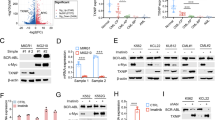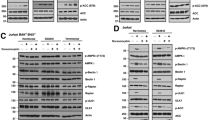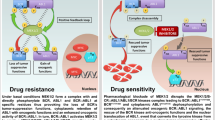Abstract
Overexpression of protein kinase C α (PKC α) promotes Bcl2 phosphorylation and chemoresistance in human acute leukemia cells. The contribution of non-Bcl2 mechanisms in this process is currently unknown. In this report, overexpression of PKC α was found not to affect cell proliferation, cell cycle, or activation of mitogen-activated protein kinases. The failure of PKC α overexpression to activate non-Bcl2 survival pathways suggested that PKC α-mediated chemoresistance requires Bcl2. Supporting this notion, REH/PKC α transfectants were found to be as sensitive to HA14-1 (a drug that targets Bcl2 function) as parental cells. In addition, HA14-1 abrogated PKC α's ability to protect REH cells from etoposide. These findings suggested that Bcl2 is necessary for the protective function of PKC α in REH cells. Since Bcl2 phosphorylation status is negatively regulated by protein phosphatase 2A (PP2A) and PP2A regulates PKC α, we investigated whether PKC α can conversely regulate PP2A. Overexpression of PKC α was found to suppress mitochondrial PP2A activity by a mechanism that, at least in part, involves suppressed expression of the regulatory subunit comprising the Bcl2 phosphatase (ie the PP2A/B56 α subunit). The ability of PKC α to target both Bcl2 and the Bcl2 phosphatase represents a novel mechanism for chemoresistance.
This is a preview of subscription content, access via your institution
Access options
Subscribe to this journal
Receive 12 print issues and online access
$259.00 per year
only $21.58 per issue
Buy this article
- Purchase on Springer Link
- Instant access to full article PDF
Prices may be subject to local taxes which are calculated during checkout







Similar content being viewed by others
References
Nishizzuka Y . Intracellular signaling by hydrolysis of phospholipids and activation of protein kinase C. Science 1992; 258: 607–614.
Newton AC . Protein kinase C: structure, function, and regulation. J Biol Chem 1995; 270: 28495–28498.
Parekh DB, Ziegler W, Parker PJ . Multiple pathways control protein kinase C phosphorylation. EMBO J 2000; 19: 496–503.
Dempsey EC, Newton AC, Mochly-Rosen D, Fields AP, Reyland ME, Insel PA et al. Protein kinase C isozymes and the regulation of diverse cell responses. Am J Physiol Lung Cell Mol Physiol 2000; 279: L429–L438.
Lozano J, Berra E, Municio MM, Diaz-Meco MT, Dominguez I, Sanz L et al. Protein kinase C zeta isoform is critical for kappa B-dependent promoter activation by sphingomyelinase. J Biol Chem 1994; 269: 19200–19202.
Muller G, Ayoub M, Storz P, Rennecke J, Fabbro D, Pfizenmaier K . PKC zeta is a molecular switch in signal transduction of TNF-alpha, bifunctionally regulated by ceramide and arachidonic acid. EMBO J 1995; 14: 1961–1969.
Bourbon NA, Yun J, Kester M . Ceramide directly activates protein kinase C zeta to regulate a stress-activated protein kinase signaling complex. J Biol Chem 2000; 275: 35617–35623.
Whelan RD, Parker PJ . Loss of protein kinase C function induces an apoptotic response. Oncogene 1998; 16: 1939–1944.
Ruvolo PP, Deng X, Carr BK, May WS . A functional role for mitochondrial PKC α in Bcl2 phosphorylation and suppression of apoptosis. J Biol Chem 1998; 273: 25436–25442.
Doornbos RP, Theelen M, van der Hoeven PC, van Blitterswijk WJ, Verkleij AJ, van Bergen en Henegouwen PM . Protein kinase Czeta is a negative regulator of protein kinase B activity. J Biol Chem 1999; 274: 8589–8596.
May WS, Tyler PG, Ito T, Armstrong DK, Qatsha KA, Davidson NE . Interleukin-3 and bryostatin-1 mediate hyperphosphorylation of Bcl2a in association with suppression of apoptosis. J Biol Chem 1994; 269: 26865–26870.
Ito T, Deng X, Carr BK, May WS . Bcl2 phosphorylation required for anti-apoptosis function. J Biol Chem 1997; 272: 11671–11673.
Kyriakis JM, App H, Zhang XF, Banerjee P, Brautigan DL, Rapp UR et al. Raf-1 activates MAP kinase-kinase. Nature 1992; 358: 417–421.
Carroll MP, May WS . Protein kinase C-mediated serine phosphorylation directly activates Raf-1 in murine hematopoietic cells. J Biol Chem 1994; 269: 1249–1256.
Chang F, Steelman LS, Shelton JG, Lee JT, Navolanic PM, Blalock WL et al. Regulation of cell cycle progression and apoptosis by the Ras/Raf/MEK/ERK pathway. Int J Oncol 2003; 22: 469–480.
McCubrey JA, May WS, Duronio V, Mufson A . Serine/threonine phosphorylation in cytokine signal transduction. Leukemia 2000; 14: 9–21.
Frey MR, Saxon ML, Zhao X, Rollins A, Evans SS, Black JD . Protein kinase C isozyme-mediated cell cycle arrest involves induction of p21(waf1/cip1) and p27(kip1) and hypophosphorylation of the retinoblastoma protein in intestinal epithelial cells. J Biol Chem 1997; 272: 9424–9435.
Frey MR, Clark JA, Leontieva O, Uronis JM, Black AR, Black JD . Protein kinase C signaling mediates a program of cell cycle withdrawal in the intestinal epithelium. J Cell Biol 2000; 151: 763–778.
Jarvis WD, Fornari Jr FA, Browning JL, Gewirtz DA, Kolesnick RN, Grant S . Attenuation of ceramide-induced apoptosis by diglyceride in human myeloid leukemia cells. J Biol Chem 1994; 269: 31685–31692.
Hannun YA . Functions of ceramide in coordinating cellular responses to stress. Science 1996; 274: 1855–1859.
Hannun YA, Luberto C . Ceramide in the eukaryotic stress response. Trends Cell Biol 2000; 10: 73–80.
Luberto C, Hannun YA . Sphingomyelin synthetase, a potential regulator of intracellular levels of ceramide and diacylglycerol during SV40 transformation. J Biol Chem 1998; 273: 14550–14559.
Ruvolo PP, Deng X, Ito T, Carr BK, May WS . Ceramide induces Bcl2 dephosphorylation via a mechanism involving mitochondrial PP2A. J Biol Chem 1999; 274: 20296–20300.
Ruvolo PP, Clark W, Mumby M, Gao F, May WS . A functional role for the B56 alpha-subunit of protein phosphatase 2A in ceramide-mediated regulation of Bcl2 phosphorylation status and function. J Biol Chem 2002; 277: 22847–22852.
Ruvolo PP . Ceramide regulates cellular homeostasis via diverse stress signaling pathways. Leukemia 2001; 15: 1153–1160.
Ruvolo PP . Intracellular signal transduction pathways activated by ceramide and its metabolites. Pharmacol Res 2003; 47: 383–392.
Konopleva M, Tsao T, Ruvolo P, Stiouf I, Estrov Z, Leysath CE et al. Novel triterpenoid CDDO-Me is a potent inducer of apoptosis and differentiation in acute myelogenous leukemia. Blood 2002; 99: 326–335.
Ruvolo PP, Deng X, May WS . Phosphorylation of Bcl2 and regulation of apoptosis. Leukemia 2001; 15: 515–522.
Gschwend JE, Fair WR, Powell CT . Bryostatin 1 induces prolonged activation of extracellular regulated protein kinases in and apoptosis of LNCaP human prostate cancer cells overexpressing protein kinase c alpha. Mol Pharmacol 2000; 57: 1224–1234.
Deng X, Ruvolo P, Carr B, May WS . Survival function of ERK1/2 as IL-3-activated staurosporine-resistant Bcl2 kinases. Proc Natl Acad Sci USA 2000; 97: 1578–1583.
Budihardjo I, Oliver H, Lutter M, Luo X, Wang X . Biochemical pathways of caspase activation during apoptosis. Annu Rev Cell Dev Biol 1999; 15: 269–290.
Wang JL, Liu D, Zhang ZJ, Shan S, Han X, Srinivasa M et al. Structure-based discovery of an organic compound that binds Bcl-2 protein and induces apoptosis of tumor cells. Proc Natl Acad Sci USA 2000; 97: 7124–7129.
Milella M, Estrov Z, Kornblau SM, Carter BZ, Konopleva M, Tari A et al. Synergistic induction of apoptosis by simultaneous disruption of the Bcl-2 and MEK/MAPK pathways in acute myelogenous leukemia. Blood 2002; 99: 3461–3464.
Chen J, Freeman A, Liu J, Dai Q, Lee R . The apoptotic effect of HA14-1, a Bcl-2-interacting small molecular compound, requires Bax translocation and is enhanced by PK11195. Mol Cancer Ther 2002; 1: 981–987.
Lee JY, Hannun YA, Obeid LM . Ceramide inactivates cellular protein kinase C α. J Biol Chem 1996; 271: 13169–13174.
Lee JY, Hannun YA, Obeid LM . Functional dichotomy of protein kinase C (PKC) in tumor necrosis factor-alpha (TNF-alpha) signal transduction in L929 cells. Translocation and inactivation of PKC by TNF-alpha. J Biol Chem 2000; 275: 29290–29298.
Chen J, Martin BL, Brautigan DL . Regulation of protein serine–threonine phosphatase type-2A by tyrosine phosphorylation. Science 1992; 257: 1261–1264.
Chen J, Parsons S, Brautigan DL . Tyrosine phosphorylation of protein phosphatase 2A in response to growth stimulation and v-src transformation of fibroblasts. J Biol Chem 1994; 269: 7957–7962.
Xu Z, Williams BR . The B56 alpha regulatory subunit of protein phosphatase 2A is a target for regulation by double-stranded RNA-dependent protein kinase PKR. Mol Cell Biol 2000; 20: 5285–5299.
Mumby MC, Walter G . Protein serine/threonine phosphatases: structure, regulation, and function in cell growth. Physiol Rev 1993; 73: 673–699.
Watanabe T, Ono Y, Taniyama Y, Hazama K, Igarashi K, Ogita K et al. Cell division arrest induced by phorbol ester in CHO cells overexpressing protein kinase C-delta subspecies. Proc Natl Acad Sci USA 1992; 89: 10159–10163.
Cacace AM, Guadagno SN, Krauss RS, Fabbro D, Weinstein IB . The epsilon isoform of protein kinase C is an oncogene when overexpressed in rat fibroblasts. Oncogene 1993; 8: 20095–20104.
Mischak H, Goodnight JA, Kolch W, Martiny-Baron G, Schaechtle C, Kazanietz MG et al. Overexpression of protein kinase C-delta and -epsilon in NIH 3T3 cells induces opposite effects on growth, morphology, anchorage dependence, and tumorigenicity. J Biol Chem 1993; 268: 6090–6096.
Han EK, Cacace AM, Sgambato A, Weinstein AB . Altered expression of cyclins and c-fos in R6 cells that overproduce PKC epsilon. Carcinogenesis 1995; 16: 2423–2428.
Haldar S, Jena N, Croce CM . Inactivation of Bcl2 by phosphorylation. Proc Natl Acad Sci USA 1995; 92: 4507–4511.
Maundrell K, Antonsson B, Magnenat E, Camps M, Muda M, Chabert C et al. Bcl2 undergoes phosphorylation by c-Jun N-terminal/stress-activated protein kinase in the presence of constitutively active GTP binding protein Rac-1. J Biol Chem 1997; 272: 25238–25242.
Yamamoto K, Ihijo H, Korsmeyer S . Bcl2 is phosphorylated and inactivated by an ASK1/Jun N-terminal protein kinase pathway normally activated at G2/M. Mol Cell Biol 1999; 19: 8469–8478.
Deng X, Ito T, Carr B, Mumby M, May WS . Reversible phosphorylation of Bcl2 following interleukin-3 or bryostatin-1 is mediated by direct interaction of protein phosphatase 2A. J Biol Chem 1998; 273: 34157–34163.
Acknowledgements
This work was supported by the National Institute of Health Grant CA30715-01 (PPR).
Author information
Authors and Affiliations
Corresponding author
Rights and permissions
About this article
Cite this article
Jiffar, T., Kurinna, S., Suck, G. et al. PKC α mediates chemoresistance in acute lymphoblastic leukemia through effects on Bcl2 phosphorylation. Leukemia 18, 505–512 (2004). https://doi.org/10.1038/sj.leu.2403275
Received:
Accepted:
Published:
Issue Date:
DOI: https://doi.org/10.1038/sj.leu.2403275
Keywords
This article is cited by
-
ATF4/CEMIP/PKCα promotes anoikis resistance by enhancing protective autophagy in prostate cancer cells
Cell Death & Disease (2022)
-
Increased PKCα activity by Rack1 overexpression is responsible for chemotherapy resistance in T-cell acute lymphoblastic leukemia-derived cell line
Scientific Reports (2016)
-
Fast calcium wave inhibits excessive apoptosis during epithelial wound healing
Cell and Tissue Research (2016)
-
Effect of PKCα expression on Bcl-2 phosphorylation and cell death by hypericin
Apoptosis (2014)
-
Antiepileptic drugs reduce efficacy of methotrexate chemotherapy by downregulation of Reduced folate carrier transport activity
Leukemia (2009)



